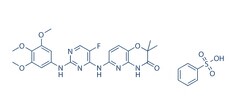R406 BenzenesulfonateCAS号: 841290-81-1分子式: C22H23FN6O5·C6H6O3S分子量: 628.63描述纯度储存/保存方法别名可溶性/溶解性靶点In vitro(体外研究)In vivo(体内研究)参考文献
| 产品描述 | |
| 描述 |
R406是一种有效的Syk抑制剂,无细胞试验中IC50为41 nM,对Syk抑制作用强,但是不抑制Lyn,对Flt3的作用比对Syk低5倍。 |
| 纯度 |
≥98%
|
| 储存/保存方法 |
Store at -20℃ for one year(Powder);Store at 2-4℃ for two weeks;Store at -20℃ for six months after dissolution.
|
| 基本信息 | |
| 别名 |
R 406; R-406
|
| 可溶性/溶解性 |
DMSO :100 mg/mL (159.07 mM)
Ethanol :8 mg/mL (12.72 mM) |
| 生物活性 | |
| 靶点 |
Flt3 ,Syk
|
| In vitro(体外研究) |
R406 is a potent inhibitor of immunoglobulin E (IgE)- and IgG-mediated activation of Fc receptor signaling. R406 inhibits the anti-IgE-induced production and release of LTC4 and cytokines and chemokines, including TNFα, IL-8, and GM-CSF. R406 inhibits phosphorylation of Syk substrate linker for activation of T cells in mast cells and B-cell linker protein/SLP65 in B cells. R406 binds to the ATP binding pocket of Syk and inhibits its kinase activity as an ATP-competitive inhibitor with Ki of 30 nM. R406 blocks Syk-dependent FcR-mediated activation of monocytes/macrophages and neutrophils and Bcr-mediated activation of B lymphocytes. R406 significantly induces chronic lymphocytic leukemia (CLL) cell apoptosis in nurselike cells cocultures and blocks CCL3 and CCL4 secretion by CLL cells in response to B-cell antigen receptor (Bcr) triggering. R406 is a potent inhibitor of platelet signaling and functions initiated by FcγRIIA cross-linking by specific antibodies or by sera from HIT patients.
|
| In vivo(体内研究) |
R406 reduces cutaneous reverse passive Arthus reaction by approximately 86% at 5 mg/kg in prophylactic treated mice. R406 also shows efficacy in inhibiting paw inflammation in antibody-induced arthritis mouse models. R406 does not adversely affect macrophage or neutrophil function in innate immune responses and has minimal functional immunotoxicity notwithstanding its lymphocytopenic effect.
|
| 参考文献 | |
| 参考文献 |
[1] Braselmann S, et al. J Pharmacol Exp Ther, 2006, 319(3), 998-1008. [2] Quiroga MP, et al. Blood, 2009, 114(5), 1029-1037. [3] Lhermusier T, et al. J Thromb Haemost, 2011, 9(10), 2067-2076. [4] Zhu Y, et al. Toxicol Appl Pharmacol, 2007, 221(3), 268-277. |
分子结构图

